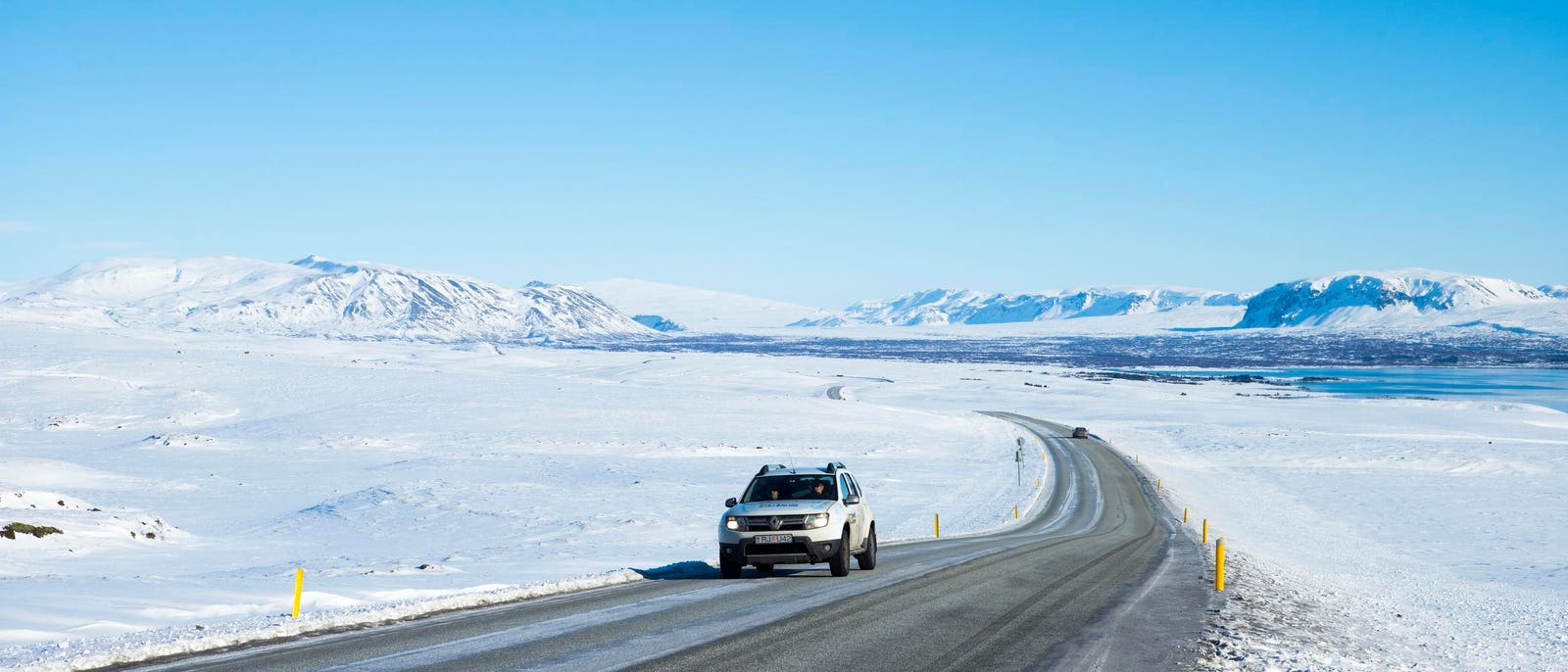Driving throughout Iceland — an increasingly popular destination for American travelers — is an incredible, magical experience with waterfalls, glaciers and stunning geography nearly everywhere. The highways are void of potholes, the accident rate is low and the country was called the world’s safest in a report released Tuesday by an insurance company, but the roads can present dangers to unsuspecting tourists.
Iceland’s two-lane, 820-mile Ring Road (Route 1) loops around the country and is the main road used to access popular tourist sites. The Ring Road lacks shoulders and guardrails, and much of the highway is elevated, posing a possible rollover for a vehicle straying off the road.
Many visitors heading to the Icelandic coutryside travel on the south road from Reykjavik. (Photo by Tim Graham/Getty Images)
Getty Images
Rental car outlets provide lots of helpful safety tips on their websites, but a check of various companies’ websites didn’t find one that warned about the lack of shoulders and guardrails or the elevated roadway.
According to the Icelandic Transport Authority, there have been 13 fatalities in traffic accidents so far this year. That is the largest number since the full year of 2018, when 15 people were killed, says the Reykjaviik Grapevine, an English-language magazine.
The transport authority’s website posts more in-depth statistics for the first five months this year. Auto accidents seriously injured 62 people and slightly injured 460 people during that time period. There were seven fatal accidents, 46 serious accidents, 296 minor accidents and 2,920 incidents without injuries during the five months.
Some accidents reported this year:
*On September 24, a car overturned in Skagi in northwestern Iceland. The driver was killed, and a passenger was transported by ambulance to a hospital, according to the Iceland Monitor news and information website.
*On August 12, the website reported that the Ring Road was temporarily closed near the Gígjukvísl River after two cars collided and four people — American and Spanish tourists — were injured.
*On May 25, 27 people were injured, including some with major injuries, when a bus overturned on Rangárvallavegur road near Stokkalækur, according to the Iceland Monitor.
*On January 12, two foreign tourists were killed, and six others were airlifted to a hospital, after two cars collided head-on on the Ring Road near Vatnajökull National Park, the Reykjaviik Grapevine reported.
The Ring Road, the most traveled road around Iceland, lacks shoulders and guardrails and has many elevated stretches. (Photo by Athanasios Gioumpasis/Getty Images)
Getty Images
Iceland and other Nordic countries “are among the best-performing countries in Europe and the world when it comes to fatalities in traffic per capita,” says the Icelandic Transport Authority. “The countries have seen a steady decline in fatalities over the last 10 years, although the numbers in Iceland and the Faroe Islands are too small to give indication of trends.”
Iceland “has seen consistent improvement in its road safety record over recent years,” says a report by the International Transport Forum, which is part of the intergovernmental Organisation for Economic Co-operation and Development. “However, there were many road deaths 2015-2018, due, in part, to a greater number of foreign tourists driving rental cars.”
Many crashes occur along the Ring Road, which traverses many sparsely populated areas, the forum’s report says. The road “can be subject to poor weather conditions, including snow, frigid temperatures, high winds and rain. In addition, single-lane bridges constructed of wood or steel, blind curves and gravel road surfaces in some areas can pose additional hazardous conditions for travelers.”
The Icelandic Association for Search and Rescue provides its safety advice.
“Conditions in Iceland might be different from what you‘re used to,” the association warns. “The beautiful landscapes can easily draw the driver’s attention away from the road, or sheep could jump onto the road in front of your car. In order to reach your destination safely, you must keep your full attention on driving.”
After arrival in Iceland after a long flight, often very early in the morning, it may be a bad idea to drive, the association says.
Holdur Car Rental, the Europcar franchisee in Iceland, warns renters on its website that driving in Iceland can be more challenging than in other countries, because “you can experience a variety of weather at any time of the year.” Thick fog, snow and high winds can “pose additional challenges,” the rental car company says.
Hertz’s website warns renters that Iceland’s weather changes rapidly, even in summer. “Never be surprised if you experience the four seasons in one day: excellent weather and lovely sunshine in the morning, and, all of a sudden, it starts raining or snowing with no signs in advance,” the website says.
